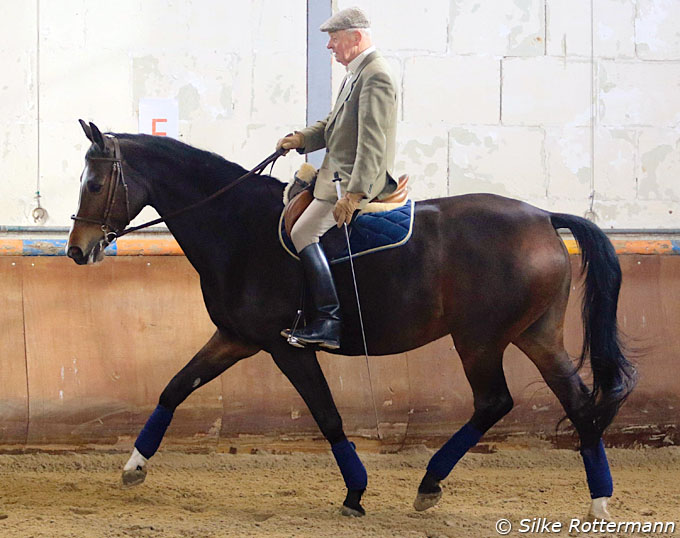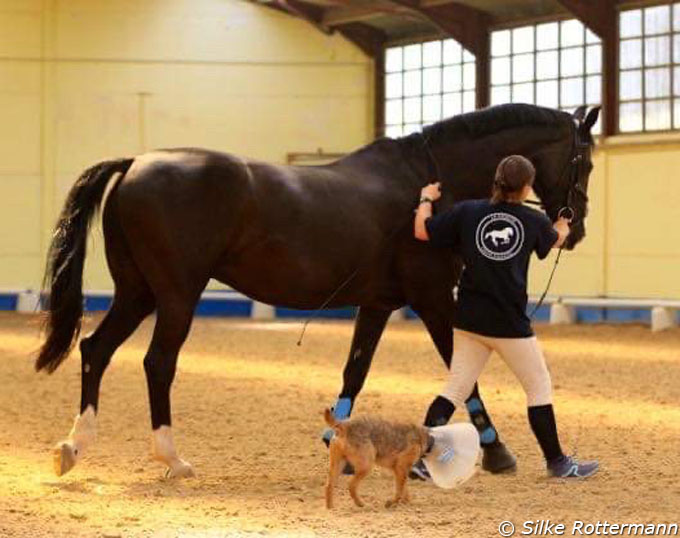
Horses react differently to leg aids. While some tend to think forward very easily, others react by slowing down in a situation that is not clear or comfortable. For the rider this usually feels like the horse is not in front of the leg, like the horse is thinking backwards even if it still is moving forward.
If the horse clearly avoids to move easily forward with or without the rider, or if he is showing signs that the situation may escalate towards rearing or other severe resisting behaviour, it is wise to have a talk with the vet about the situation as it sometimes may be necessary to check if the horse is having pain or other reasons to avoid the movement. Even the tack, especially the saddle and the girth, needs to be checked then.
Resetting leg aids
The correction itself needs to be as simple and straight forward as possible. The key is hidden in how simple the aids are and how quickly the situation becomes comfortable for the horse. For this we need to be sure that the rider doesnt become tense in a way that might make the correction slower or more difficult because of unclear or contradictory aids.
Typical scenarios for the rider:

- Lifting the heel up. This is often combined with a lifted knees and flexed hips, resulting in a tight lower back and possibly a slightly forward leaning seat. The rider’s pelvis is no longer in a neutral position, resulting in a movement that is restricting the feeling for the horse. The rider may also end up lifting the lower leg if she is trying to over stabilize the seat with her thigh and core, then the lower leg may even become unstable.
- Squeezing with the leg. This is often combined with a forward pushing seat, resulting in tightness in the rider’s hips and core. Riders sometimes try to turn toes out. Squeezing often becomes unconscious, or the rider feels that if she stops squeezing, the horse will stop moving. Squeezing can also result in an unstable lower leg and even the whole seat.
Correction of the horse’s response
If the horse’s response to leg aids has become too slow or weak, the tissues (the skin, and the superficial and deeper tissues) usually still have the ability to sense and feel even the slightest aids. To solve this it is practical to use a patient attitude combined with a whip, which should be a tool that will not make the horse worried. If the horse is not comfortable with the whip, it is indispensable to teach this to the horse first before proceeding.

fine- tune the forward aid.
The leg aid is given very gently but clearly, and then this can be combined with a soft, yet clearly increasing tapping of the whip, which is placed behind the riders leg. It is important for the rider to feel how intense the tapping should be. The pressure and time between each touch also depends on the horse, but often an imagined trot rhythm seems quite suitable. The horse absolutely must not be afraid, but there needs to be a clear reaction pretty quickly, after a few touches, so the rider adjusts the aid so that she feels that the horse is going to respond forward. When the horse reacts a little forward, the tapping is stopped and the rider praises the horse. Then this is repeated, adjusting the aid towards a smaller aid.
The way to ask for a reaction is calm but effective. The reaction is asked in a peaceful working atmosphere which is indispensable. If the rider is annoyed, the communication and quality of the aids is no more on a good, sensitive level. If the horse is very nervous, it will not be able to response in a correct way. If the aid is too small, there will not be reaction or the aid becomes just an unclear, unnecessary tapping. The rider should think of the good forward movement in his body, to have the direction and the energy existing. With some horses it seems practical to use a little quicker leg aid, thinking of an “electrical” quick aid with just a little pressure. Other horses seem to understand this whip aid easier from the ground, and others find it more clear from the rider sitting in the saddle. It is important that the rider reads the situation well, so that the horse won’t get worried, but that the aid is creating a correct kind of reaction.
Correcting the leg aid

touch with the lower leg and allows the horse’s
movement to flow forward.
by Niina Kirjorinne for Eurodressage
Photos © Jan Reumann - Silke Rottermann
Related Links
Functionality in Equitation: Skin Damage from Leg Aids
Functionality in Equitation: The Forward Thinking Hand
Functionality in Equitation: Balance, the Key in Equitation
Functionality in Equitation: Aim for Good Movement
Functionality in Equitation: Fascia and Movement
Functionality in Equitation: Fascia Treament - Surface Has a Deep Effect
Meet Niina Kirjorinne, Classical Dressage Rider and Physiotherapist
Effect of Noseband Positioning to Fascial and Neural Dynamics of the Head